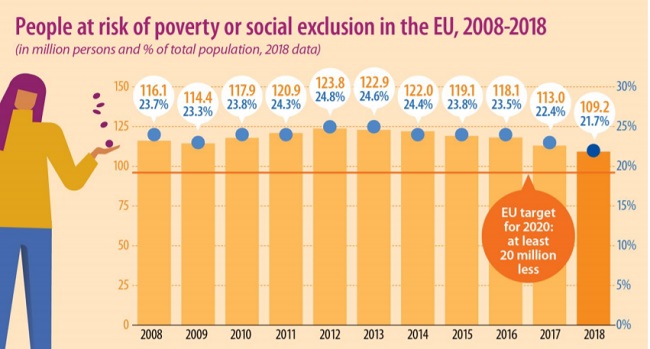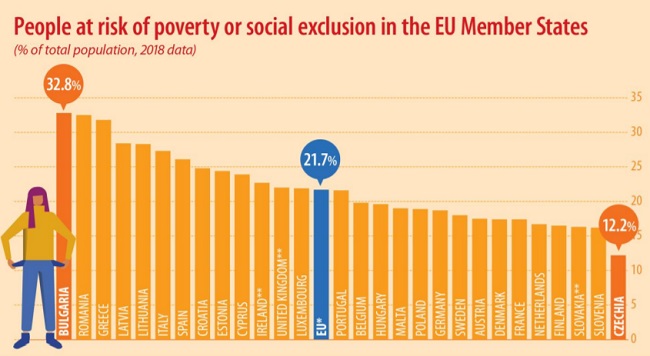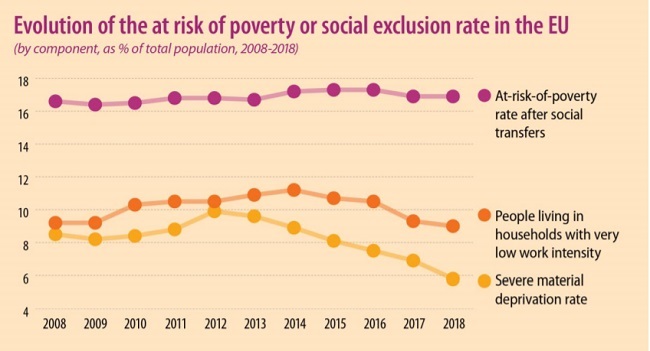Analytics, Baltic, EU – Baltic States, Latvia, Quality of life, Statistics
International Internet Magazine. Baltic States news & analytics
Wednesday, 31.12.2025, 12:38
Latvia has highest proportion of people at risk of poverty or social exclusion in Baltics - Eurostat
 Print version
Print versionAfter three consecutive increases between 2009 and 2012 to
reach almost 25%, the proportion of persons at risk of poverty or social
exclusion in the EU has since continuously decreased to 21.7% last year, 2
percentage points below its 2008 reference-point and 0.7 percentage points
below the 2017 level.
Despite this fall from the peak in 2012 (123.8 mln people),
only 8.2 mln people (including Croatia) were lifted out of the risk of poverty
or social exclusion compared to the 2008 baseline (116.1 mln excluding
Croatia). This number remains at a distance from the Europe 2020 target:
lifting at least 20 mln people out of the risk of poverty and social exclusion
compared to the baseline. The reduction of the number of persons at risk of
poverty or social exclusion in the EU is one of the key targets of the Europe
2020 strategy. These figures are published by Eurostat, the statistical office
of the European Union, on the International Day for the Eradication of Poverty.
An infographic is also available on the Eurostat website.

Highest at risk of poverty or social exclusion rate in Bulgaria, lowest in Czechia
In 2018, more than a quarter of the population was at risk
of poverty or social exclusion in seven Member States: Bulgaria (32.8%),
Romania (32.5%), Greece (31.8%), Latvia (28.4%), Lithuania (28.3%), Italy
(27.3%) and Spain (26.1%).
At the opposite end of the scale, the lowest shares of
persons being at risk of poverty or social exclusion were recorded in Czechia
(12.2%), Slovenia (16.2%), Slovakia (16.3%, 2017 data), Finland (16.5%), the
Netherlands (16.7%), Denmark and France (both 17.4%) and Austria (17.5%).

Largest decrease in Bulgaria, highest increase in Luxembourg
Among Member States for which 2018 data are available, the
at risk of poverty or social exclusion rate has grown since 2008 in nine Member
States: Luxembourg (from 15.5% in 2008 to 21.9% in 2018, or +6.4 percentage
points) Greece (+3.7 pp), Estonia (+2.6 pp), Spain (+2.3 pp), Italy and the
Netherlands (both +1.8 pp), Sweden (+1.3 pp), Denmark (+1.1 pp) and Cyprus
(+0.6 pp).
In contrast, the
largest decrease was observed in Bulgaria (from 44.8% to 32.8%, or -12.0 pp),
Romania (-11.7 pp) and Poland (-11.6 pp), followed by Hungary (-8.6 pp) and
Latvia (-5.8 pp).
About 1 in 6 persons in the EU at risk of income poverty…
Looking at each of the three elements contributing to being
at risk of poverty or social exclusion, 16.9% of the EU population were at risk
of poverty after social transfers in 2018, meaning that their disposable income
was below their national at risk of poverty threshold. This proportion is
stable compared with 2017 (16.9%), but is still slightly higher than in 2008
(16.6%). As the thresholds reflect actual income distribution in the countries,
they vary greatly both between Member States and over time.
Across the EU Member States, more than 1 in 5 persons were
at risk of income poverty in Romania (23.5%), Latvia (23.3%), Lithuania
(22.9%), Bulgaria (22.0%), Estonia (21.9%), Spain (21.5%) and Italy (20.3%). In
contrast, the lowest rates were observed in Czechia (9.6%), Finland (12.0%),
Slovakia (12.4%, 2017 data), Denmark (12.7%), Hungary (12.8%), the Netherlands
and Slovenia (both 13.3%) and France (13.4%). Compared with 2008, the
proportion of persons at risk of income poverty has increased in sixteen Member
States, for which data are available, and decreased in eight.
… 1 in 17 severely materially deprived…
In the EU in 2018, 5.8% of the population were severely
materially deprived, meaning that they had living conditions constrained by a
lack of resources such as not being able to afford to pay their bills, keep
their home adequately warm, or take a one week holiday away from home. This
proportion has decreased compared with both 2017 (6.6%) and 2008 (8.5%). The
share of those severely materially deprived in 2018 varied significantly among
Member States, ranging from 20.9% in Bulgaria, 16.8% in Romania and 16.7% in
Greece, to less than 4% in Luxembourg (1.3%), Sweden (1.6%), the Netherlands
(2.4%), Czechia, Austria and Finland (all 2.8%), Malta (3.0%), Germany (3.1%),
Denmark (3.4%), Slovenia (3.7%) and Estonia (3.8%). Compared with 2008, the
proportion of persons severely materially deprived has increased in seven
Member States for which data are available, and decreased in seventeen.
…and 1 in 11 living in households with very low work intensity
Looking at low work intensity, 9.0% of the population aged
0-59 in the EU lived in households where the adults worked less than 20% of
their total work potential during the past year. This proportion has decreased
compared with 2017 (9.5%) and is also lower than the 2008 level (9.2%). Ireland
(16.2%, 2017 data), Greece (14.6%), Belgium (12.1%), Italy (11.3%), Croatia
(11.2%), Denmark (11.1%), Finland (10.8%) and Spain (10.7%) had the highest
proportions of those living in very low work intensity households, while
Czechia (4.5%), Estonia (5.2%), Slovenia (5.4%), Slovakia (5.4%, 2017 data),
Malta (5.5%), Poland (5.6%) and Hungary (5.7%) had the lowest. Compared with
2008, the share of persons aged 0-59 living in households with very low work
intensity has increased in fourteen Member States for which data are available,
and decreased in ten.









 «The Baltic Course» Is Sold and Stays in Business!
«The Baltic Course» Is Sold and Stays in Business!

